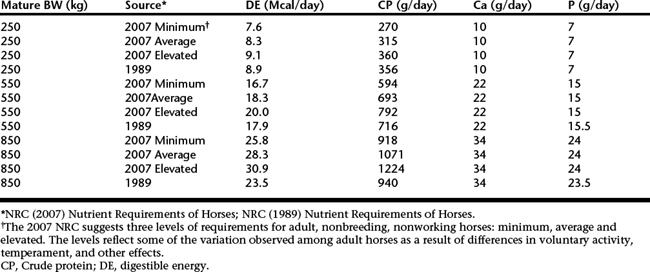CHAPTER 16 Updates to the Nutrient Requirements of the Horse: NRC 2007 Guidelines
The National Research Council (NRC), which was established in 1916 as the working arm of the National Academy of Sciences, produces many reports, including several related to the nutrient requirements of domestic animals. The NRC published the first edition of the Nutrient Requirements of Horses in 1961. Subsequent editions were released in 1966, 1973, 1978, and 1989. A committee to produce a sixth revision of the document was appointed in March 2004, and the report was released in 2007. Projects of the NRC are produced from the work of volunteer committees and are funded by nongovernmental sources. Much of the funding for this project was obtained from the livestock feed industry and equine breed organizations. Funds are used to support committee meetings, NRC staffing, and the technical aspects of publishing the document. Committees are appointed to reflect diversity in professional expertise and practical experience. The final report is compiled on the basis of published and unpublished research and consensus-driven discussion. Before publication, each report is submitted to rigorous independent review and revised appropriately. The sixth revised edition of the “Nutrient Requirements of Horses” was reviewed by equine nutritionists, feed industry professionals, and veterinarians from the United States, United Kingdom, and Germany.
NONBREEDING ADULT HORSES
The daily digestible energy (DE), crude protein (CP), calcium (Ca), and phosphorus (P) requirements of adult nonworking horses with mature body weights of 250, 550, and 850 kg (550, 1210, and 1870 lbs) are summarized (Table 16-1). Included are the 2007 and 1989 NRC recommendations. For the average 550-kg light horse, the 2007 and 1989 recommendations are similar. However, for the 250-kg pony and 850-kg draft horse, there are differences worth noting. In the 2007 NRC, DE and CP intakes for adult nonworking horses are calculated on a body-weight basis. However, in previous editions, methods were used that resulted in higher intakes per unit of body weight for smaller animals and lower intakes per unit of body weight for larger animals. The previous approach was founded on concepts relating surface area to body mass, which may apply across very broad ranges of animals. However, when that approach was applied to horses, it resulted in higher DE and CP requirements per unit of body weight for a pony than for a Thoroughbred. The new recommendations for DE and CP intake of ponies at the minimum and average levels are lower than the 1989 recommendations. Practical experience suggests that these lower values may be more appropriate for ponies because they are generally considered to be easy keepers compared with many light horses. However, if the minimum and average intakes prove to be too low, the elevated level is similar to the 1989 recommendation. The 2007 recommendations for DE and CP intakes of draft horses with average voluntary activity and an average temperament are higher than the 1989 recommendations (again, because of the different method used to calculate the requirements). In many cases, draft horses are considered easy keepers. Therefore, the minimum level of daily nutrient intakes may be most appropriate for nonworking draft horses.
The three levels of nutrient intake for idle horses were developed to allow better management of individual variation among horses. If a horse is receiving nutrient intakes at the average level and unwanted weight gain results, then the minimum level may be applied. Similarly, if a horse does not maintain weight when fed at the average level, then the elevated daily intakes can be used. The range of DE intakes in Table 16-1 might not encompass all horses in all situations. The 2007 NRC guidelines also address the effects of cold and hot weather on daily nutrient requirements, so daily intakes can be adjusted to reflect environmental challenges.
The daily nutrient requirements of mature, idle horses for nutrients not included in Table 16-1 are similar to those proposed in 1989 guidelines, with the exception of iodine. In the original printing of the 1989 NRC guidelines, the iodine requirement was set at 0.1 mg/kg dietary dry matter (approx 1.1 mg/day for a 550-kg horse). A later printing of the same publication contained a range of values that would result in daily iodine intakes between 1.1 and 6.6 mg/d for a 550-kg horse. The 2007 NRC guidelines set the iodine requirement of a 550-kg, nonworking, nonbreeding adult horse at 3.85 mg/day (0.007 mg/kg body weight).
REGULARLY EXERCISED ADULT HORSES
The ability to quantify exercise is one of the greatest obstacles to estimating accurately the daily nutrient requirements of exercising horses. In the 1989 NRC, there were three categories for exercise: light, moderate, and intense. It would be convenient to list requirements for various events (e.g., barrel racing, show jumping, and endurance racing), but the variation in stage of training and level of competition among horses performing the same type of event is substantial. The 2007 NRC summarizes a method to determine the DE requirements of individual horses, but it is cumbersome. In addition, comparable methods were not suggested for other nutrients.
Stay updated, free articles. Join our Telegram channel

Full access? Get Clinical Tree



